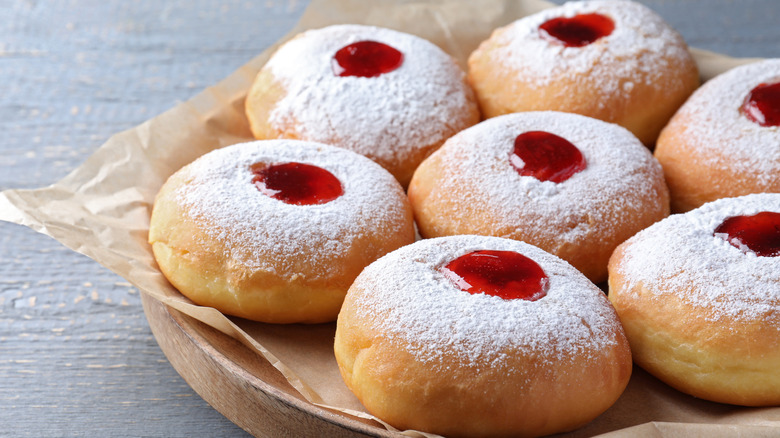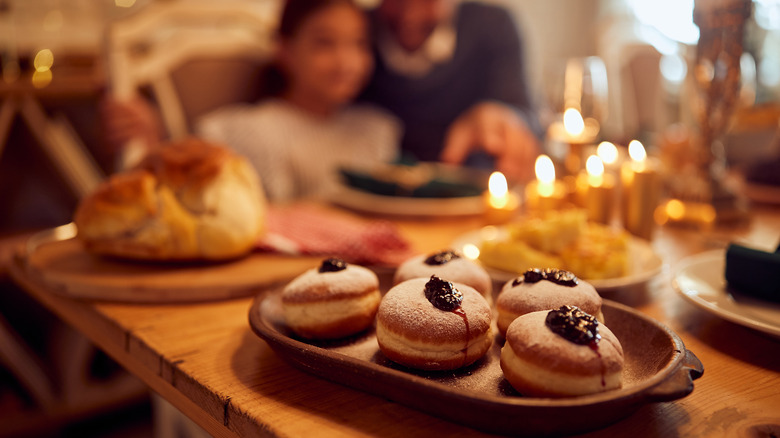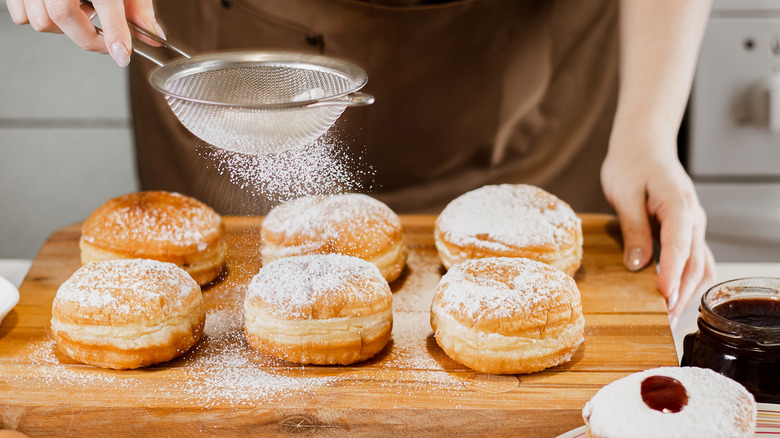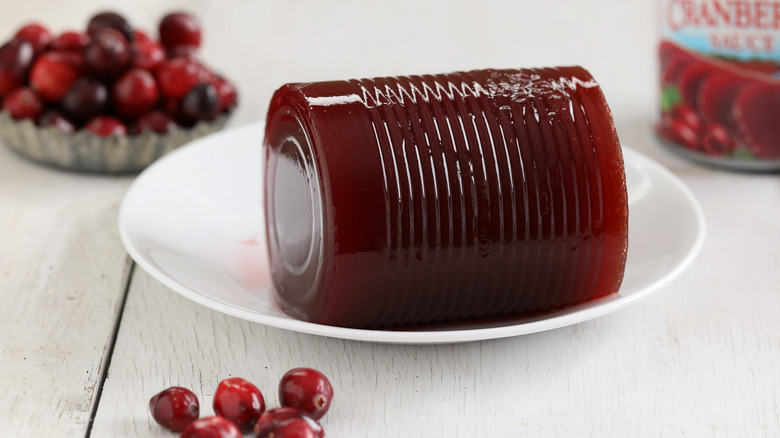The Unexpected Reason Jelly Doughnuts Became A Hanukkah Staple
If you've never celebrated the Jewish holiday of Hanukkah, then you haven't experienced the joy of eating fried food for eight straight nights in a row. The current-day holiday of Hanukkah, which falls on a different day each year, commemorates the victory of a group of Jews known as the Maccabees, who revolted against Syrian-Greek armed forces in Judea. A pivotal moment of the revolt occurred in 165 B.C. when the Maccabees successfully defeated a Syrian-Greek army that had seized the sacred Jewish Temple in Jerusalem years earlier.
As part of the rededication of the Temple, the Maccabees lit the traditional Jewish oil lamp known as a menorah. As the story goes, they used olive oil, and although it was only enough to last for one day, it burned for eight days and nights. Ever since then, Jewish people light a chanukiah (a version of the menorah with nine candles, rather than seven) every night during Hanukkah — but in a tip of the hat to the oily miracle, Hanukkah celebrations usually include a fried food, such as the potato fritters known as latkes, and doughnuts (called sufganiyot) for dessert.
Doughnuts fit right in with a holiday all about oil
You're probably familiar with crispy, salty potato latkes, that classic Hanukkah food that's fried in plenty of oil as a way to commemorate the original Hanukkah miracle. But did you know that since the early 20th century, fried jelly doughnuts have crowded Hanukkah tables as well?
The round, jelly-stuffed, powdered sugar-topped doughnuts known as sufganiyot in Hebrew became a popular Hanukkah treat in the British Mandate of Palestine (modern-day Israel) starting in the late 1920s (via The Atlanta Jewish Times). Prior to that, potato latkes had been the fried delight of choice, but in those years, the jelly doughnuts arrived by way of Poland — where they were called ponchik — and were promoted by a labor federation as a way to create jobs in the Levant. Folks were able to find work making, delivering, and selling the sticky desserts; after all, doughnuts are not that easy to make at home, so people were more apt to buy them.
Sufganiyot were deliberately pushed as a tradition
In the first half of the 20th century, an organization called the Israeli Histadrut sought to integrate Jews further into the fabric of society in British-mandated Palestine. Building on the traditions of Russian socialism, one of its goals to accomplish this was full employment for members of the Jewish community. Enter jelly doughnuts.
Sufganiyot aren't like latkes; pretty much anyone can make what are essentially grated and fried potato pancakes. Sufganiyot, though, are much trickier, typically requiring a professional baker's skilled hand. The Histadrut knew this and deliberately sought to push them as a "traditional" treat during Hanukkah after the end of autumnal holidays like Rosh Hashanah, Sukkot, and Shemini Atzeret left a dry spell in business for Jewish bakers. After all, if the new Hanukkah Hotness was something you had to go to a professional to get, it meant those professionals would make a lot more money. It worked like a charm, and now sufganiyot are as much a part of Hanukkah tradition as the menorah. This is particularly true in Israel, where 18 million sufganiyot (around three per person) are eaten around the holiday each year.
A lot of holiday traditions aren't nearly as old as we think
Historically, this isn't all that unusual; many things we think of as holiday "traditions" haven't actually been around that long. Elf on a Shelf has only existed since 2005, ugly sweater parties only appeared in the 1980s, and advent calendars didn't catch on until the 1920s. Canned cranberry sauce on Thanksgiving wasn't a thing until the late 1800s. It makes sense that if Christmas and Thanksgiving holiday traditions are much newer than we'd expect, Hanukkah ones might be as well.
The tradition ultimately spread to America, where sufganiyot gained traction as a Hanukkah food, likely in no small part due to Jewish contributions to American doughnuts. Now, all manner of inventive recipes for the fritters have appeared, from Israeli-American chef Alon Shaya's baharat-spiced sufganiyot with espresso fudge to Jewish food blogger Amy Kritzer's version stuffed with a chocolate-lime cream. So, in preparation for Hanukkah this year, you might want to bust out some dry yeast, a deep pan, and plenty of oil.



